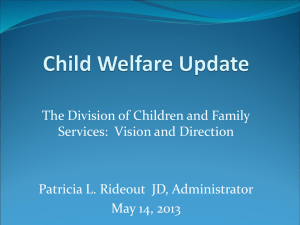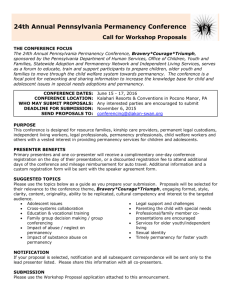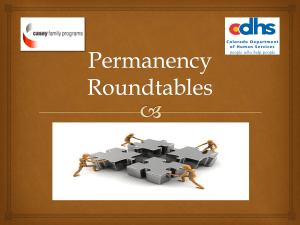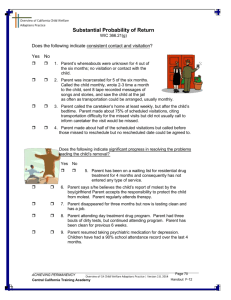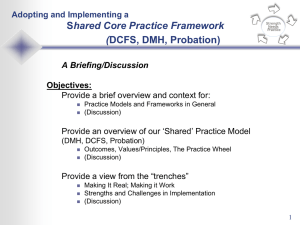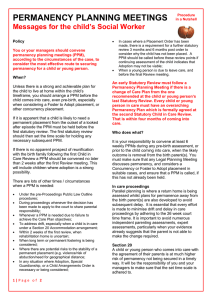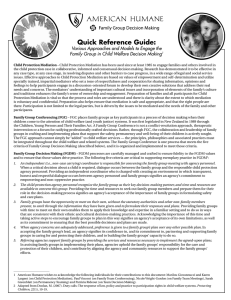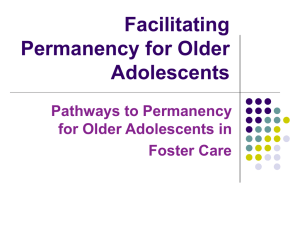Maximizing Potential: Measuring What Matters
advertisement
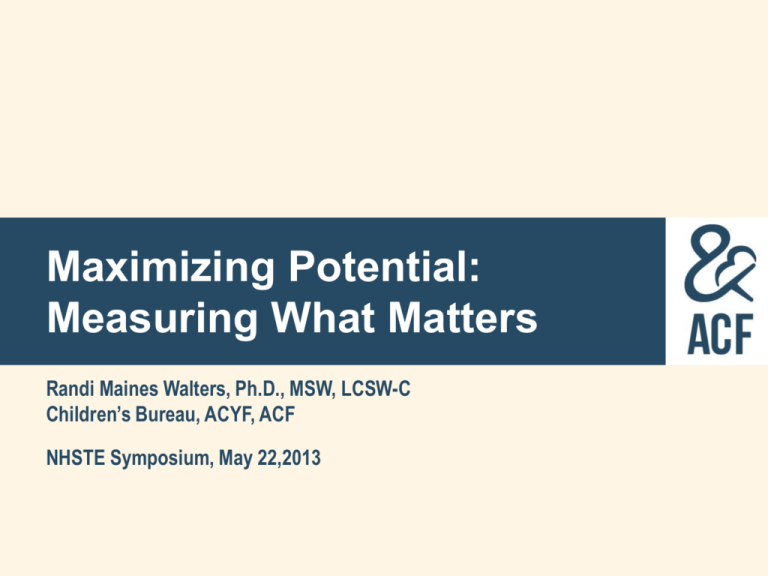
Maximizing Potential: Measuring What Matters Randi Maines Walters, Ph.D., MSW, LCSW-C Children’s Bureau, ACYF, ACF NHSTE Symposium, May 22,2013 Greetings & Acknowledgements Greetings From: Joe Bock, Acting Associate Commissioner Jane Morgan, Director of Capacity Building Division Special Thanks To: • Nancy Dickinson • Freda Bernotavicz • Robin Leake • Mary McCarthy 5/22/2013 2 Why NHSTE Matters So Much Measuring Performance: How Do We Know Training Is Making An Impact? Your Contribution To The Field Building The Evidence Base For Training That Improves Outcomes For Children and Families ‘ .” “THE WAY TO MEASURE THE VALUE OF SOMETHING IS NOT BY WHAT YOU GET OUT OF IT, IT’S WHAT YOU BECOME FROM IT.” Oliver Wendell Holmes 4 5/3/2013 Maximizing Whose Potential? • The potential of vulnerable of children and families • The potential of the people that serve vulnerable children and families • The collective potential of the organizations whose missions is to develop the workforce in order to best serve children and families “….for you will never be what you ought to be until they are what they ought to be…” Martin Luther King What Matters? Integrating Safety, Permanency, and Well-Being Professional Development of Staff Organizational Culture and Climate Measuring What Matters: Safety, Permanency & Well Being Integrating Safety, Permanency, and Well Being Focus On Outcomes Using Data To Drive Outcome Performance in Key Areas ACYF’s Priority: INTEGRATING WELLBEING WITH SAFETY AND PERMANENCY TO ACHIEVE BETTER OUTCOMES FOR CHILDREN, YOUTH, AND FAMILIES WELL-BEING SAFETY PERMANENCY SOCIAL AND EMOTIONAL WELL-BEING FOR CHILDREN, YOUTH, AND FAMILIES Healing and Recovery Intensive Intervention Assessment drives individualized treatment plan with evidence-based interventions Targeted Social and Emotional Supports Systematic approaches to teaching coping skills and social skills Stress Reducing and Developmentally Appropriate Environments Safe, Supportive, and Responsive Relationships Knowledgeable and Effective Workforce Nurturing environments provide security and promote positive outcomes Supportive, responsive relationships promote healing and recovery and reinforce growing social and emotional skills Systems and policies promote and sustain screening, assessment, the use of evidence-based interventions, progress monitoring, and continuous quality improvement Adapted from the Technical Assistance Center on Social Emotional Intervention for Children and the Center on the Social and Emotional Foundations for Early Learning TITLE IV-E CHILD ABUSE AND NEGLECT DEMONSTRATION PROJECTS TITLE IV-E CHILD WELFARE DEMONSTRATION PROJECTS • HHS may waive title IV-E requirements for States with approved projects, allowing them to use funds flexibly and reinvest savings • HHS prioritized well-being and addressing trauma as the focus of the demonstrations • States are encouraged to align screening, assessment, and evidence-based interventions with the needs and characteristics of the target population in order to achieve improved wellbeing INTEGRATING SAFETY, PERMANENCY, AND WELL-BEING • Knowledge building and developing practice – Training staff and foster parents – Providing supports to staff to address secondary trauma • Validated screening & assessment – Screening and continual functional assessment that gathers information from multiple sources • Case planning and management – Requires sensitive and responsive relationship between child and social worker, birth parents, foster parents, etc. • Scaling-up of evidence-informed services – Skilled mental health providers available – Increasing capacity to deliver trauma-focused mental health treatment • Cross-system partnerships and system collaboration – Work with Medicaid and mental health respond to trauma-informed needs being identified Conradi, L; et al. (2011). Promising practices and strategies for using trauma-informed child welfare practice to improve foster care placement stability: A breakthrough series collaborative. Child Welfare. 90(6):207. MATCHING POPULATIONS, OUTCOMES, AND APPROACHES: IV-E DEMONSTRATION PROJECT EXAMPLES Population Screening & Assessment EBIs Outcomes Trauma-Focused Cognitive Behavioral Therapy - Behavior problems - PTS symptoms - Depression Children, 13-17 - Strengths & Difficulties Questionnaire - Child & Adolescent Needs & Strengths Multisystemic Therapy - Delinquency/Drugs - Peer problems - Family cohesion Children, 2-7 - Trauma Symptoms Checklist for Young Children - Infant Toddler Emotional Assessment - CBCL Parent-Child Interaction Therapy - Conduct disorders - Parent distress - Parent-child interaction Children, 8-17 - UCLA PTSD Index - Strengths & Difficulties Questionnaire - Child & Adolescent Needs & Strengths INTEGRATING SAFETY, PERMANENCY, AND WELLBEING FOR CHILDREN AND FAMILIES MEANS: 1. Focus on child & family level outcomes 2. Monitor progress for reduced symptoms and improved child/youth functioning 3. Proactive approach to social and emotional needs 4. Developmentally specific approach 5. Promotion of healthy relationships 6. Build capacity to deliver EBPs 15 Measuring What Matters: Focus On Outcomes Standardized Risk and Safety Assessments Caseworker Visits with Parents and Children Placement Stability Timeliness of Permanency Assessment of Need and Services To Meet Those Needs CB Reading Lists • Leaps and Bounds with Implementation Science – Getting To Outcomes With Abe & Co. – Understanding Stages of Implementation and Drivers of Change with Dean and Karen – Illuminating Inner and Outer Context and Seeing Coaching as a Retention Strategy with Greg – The Science of Training and Development in Organizations (Eduardo Salas, Scott Tannebaum, Kurt Kraiger, and Kimberly Smith-Jentsch, 2012) 5/22/2013 17 Implementation Framework For Strategic Improvement • Experimenting with Integrative Workplans • Theories of Change and Why We Can’t Do Without Them • Training: Necessary But Not Sufficient 5/22/2013 18 Measuring What Matters: Professional Development of Staff Broadening The Perspective From Training To Professional Development From Training To Blended Learning Systems From Individual Performance To Organizational Outcomes Measuring What Matters: Organizational Improvement Culture and Climate The Good, The Bad, The Ugly of The Marriage Between Bureaucracies and People Caring-People Changing Organizations Training Evaluation Research On Training (Salas, et al, 2012) • Properly Designed Training Works • The Way Training Is Designed, Delivered and Implemented Can Greatly Influence Its Effectiveness • Training is a systematic process – What Matters Before – What Matters During – What Matters After Training 5/22/2013 22 Six Core Principles of Improvement Carnegie Foundation Improvement Research http://www.carnegiefoundation.org/improvement-research Principles of Improvement • Make the work problem specific and user centered • Variation in performance is the core problem to address • See the system that produces the current outcomes 5/3/2013 24 Principles of Improvement • We can not improve at scale what we cannot measure • Anchor practice improvement in disciplined inquiry • Accelerate the improvement through networked communities “Continuous effort—not strength or intelligence---is the key to unlocking potential.” Winston Churchill Reading List Referenced During Presentation Aarons, G.A., Hurlburt, M., & Horwitz, S.M. (2011). Advancing a conceptual model of evidence-based practice implementation in public service sectors. Adm Policy Ment Health 38:4-23. Fixsen, D. L., Naoom, S. F., Blase, K. A., Friedman, R. M., & Wallace, F. (2005). Implementation research: A synthesis of the literature. National Implementation Research Network Glisson, C., & Schoenwald, S. K. (2005). The ARC organizational and community intervention strategy for implementing evidence-based child mental health treatments. Mental Health Services Research , 7 (4), 243-260. Wandersman, et al. (2008). Bridging the gap between prevention research and practice: The Interactive Systems Framework for dissemination and implementation. American Journal of Community Psychology, 41, 171-181. Wiseman, S., Chinman, M., Ebener, P. A., Hunter, S., Imm, P., & Wandersman, A. (2007). Getting to Outcomes: 10 steps for achieving results-based accountability. RAND Corporation.

